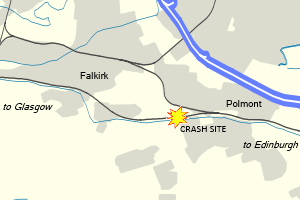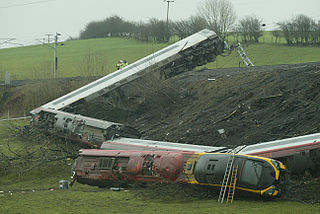
The Spanish River derailment was a rail transport accident that occurred on 21 January 1910, on the Canadian Pacific Railway (CPR) Webbwood Subdivision, where the railway crosses the Spanish River near the settlement of Nairn near Sudbury, Ontario, Canada. A westbound passenger express train derailed and crashed into the Spanish River bridge, killing at least 43 passengers, though the death count varies. The cause was never established, but was believed to be poor track condition and/or speeding and braking on a curve.

The Polmont rail accident, also known as the Polmont rail disaster, occurred on 30 July 1984 to the west of Polmont, near Falkirk, in Scotland. A westbound push–pull express train travelling from Edinburgh to Glasgow struck a cow which had gained access to the track through a damaged fence from a field near Polmont railway station, causing all six carriages and the locomotive of the train to derail. 13 people were killed and 61 others were injured, 17 of them seriously. The accident led to a debate about the safety of push–pull trains on British Rail.
The Yattalgoda train crash was an accident on a Sri Lankan rail line near the town of Kurunegala on 19 August 2001.

The Thirsk rail crash occurred on 31 July 1967 at Thirsk, Yorkshire, England on the British Rail East Coast Main Line.

The Grayrigg derailment was a fatal railway accident that occurred at approximately 20:15 GMT on 23 February 2007, just to the south of Grayrigg, Cumbria, in the North West England region of the United Kingdom. The accident investigation concluded that the derailment was caused by a faulty set of points on the Down Main running line, controlled from Lambrigg ground frame. The scheduled inspection on 18 February 2007 had not taken place and the faults had gone undetected.

The Peruman railway accident occurred on 8 July 1988 when a train derailed on the Peruman bridge over Ashtamudi Lake in Kerala, India and fell into the water, killing 105 people. The cause was never established, but was blamed on track alignment and faulty wheels, possibly compounded by a failure to notify maintenance workers about the approach of a delayed train that had been making-up time by travelling at excessive speed.

Woerden railway station is the railway station of Woerden, Netherlands. The railway station was opened on 21 May 1855 on the Utrecht–Rotterdam railway. In 1911 a new building was built in Jugendstil. During 1993-1996 the railway station was modernised, replacing the wooden roof and stairways by modern ones, while maintaining the Jugendstil building.

The Weesp train disaster took place on 13 September 1918 near Weesp, Netherlands. With 41 deaths and 42 injuries, it was the largest train disaster in Dutch railway history until the 1962 Harmelen train disaster.
The Anekal derailment occurred at 7.35 a.m. on 13 February 2015, when nine coaches of the Ernakulam-bound Intercity Express derailed near Anekal in the Bangalore Urban district of Karnataka, India. Ten people were killed and over 150 injured.

On 4 August 2015, two passenger trains – Kamayani Express and Janata Express – derailed near Kurawan and Bhringi railway station, 20 kilometres (12 mi) southwest of Harda, Madhya Pradesh. At least 31 people were killed and 100 people were injured.

The Livraga derailment is the only railway accident to date on the Italian high speed rail network. It took place on 6 February 2020 when a high-speed train derailed at Livraga, Lombardy, Italy. Two people died and 31 were injured.













